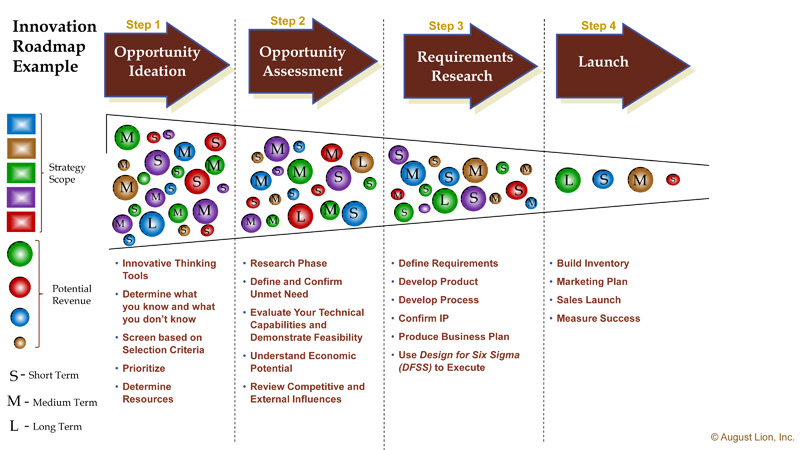Innovation Roadmaps
- Published: March 22, 2018, By Jackie Marolda
In 1989, actor Kevin Costner was hearing voices. . . 'If you build it, they will come.' Field of Dreams is a great fantasy baseball movie, with just enough sap and schmaltz to be a hit.
It also has a bit of faith. . . the character mortgages the farm to build a baseball field in the middle of his corn field, and indeed, the people came.
But, when it comes to innovation, whether it's product, process, or business model innovation, is ‘Can we build it?’ the right question to ask ourselves? Just because you can build it, should you?

The answer can be found in your innovation roadmap—a visual representation of your strategy, your projects, your timeline and your resources. Developing and using an innovation roadmap allows you to provide clear line of sight for your innovations, your entire team, and ensures that focus remains in the right areas. Here’s some key elements to include in your innovation roadmap:
- Process stages—I’ve worked with processes with as little as four stages: Design, Discover, Develop, Demonstrate, and those with as many as 12! However many stages your process includes, they must be part of your roadmap. You need to track what is in each stage, so you are constantly filling the pipeline.
- Timing—Benchmark companies for innovation have a diverse portfolio of innovation projects—short term, medium term, and long term. Short term could include incremental changes to existing projects that can be accomplished in less than a year. Medium term could be 18–36 month projects that are evolutions. Long term should include 5–10 year projects that include more blue sky ideas and revolutions.
- Market Intel—In the early stages of your process, you will have a higher percentage of assumptions compared to knowledge. In the middle of the process is where you are gathering intelligence—market intel, customer user trends, competitive data, market trends, technology trends, and offering. This intel will help you understand where your position can be, where there are market opportunities, and how you will need to enter the market. As you get to later stages, your percentage of knowledge must outweigh your percentage of assumptions.
- Scope—Innovation projects commonly suffer from scope creep. You start out with a specific hypothesis or outcome expectation, and as you learn more information you want to tack on some additional features or use the laws of subtraction which could steer the project in another direction. Guardrails must be established early and should be protected. The scope of a project is like a three-legged stool—a balancing act between time, resources and money. Scope creep can cause your stool to be unbalanced.
- Internal Capabilities/Barriers—It is essential to realistically evaluate your current capabilities to meet the innovation as well as honestly evaluate what would be needed to get any missing capabilities. Do you need to invest? Do you need to partner? Do you need to manage the channel differently?
Using an innovation roadmap that includes these key elements ensures that your entire team is aware of and working together towards similar goals and expectations. There are hundreds of examples of innovation roadmaps on the web and software available to help you create your visualizations. Or, keep it simple and use PowerPoint—colors, shapes, and text sizes can help you provide the differentiation you need. I’ve included a sample—just for demonstration purposes above.
If you follow your roadmap through your process and through the key elements, you’ll answer not only 'can we build it?', but 'should we build it?' And, then, they will come.
Share your ideas on roadmapping innovation with me at This email address is being protected from spambots. You need JavaScript enabled to view it..




